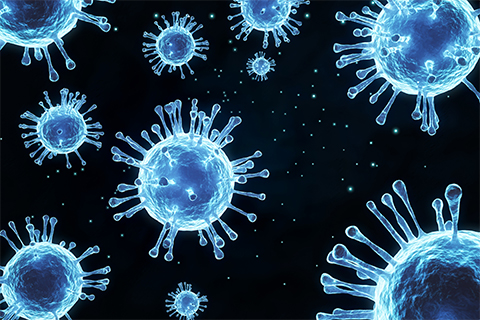From the Journals: MCP
Rapid and precise SARS-CoV-2 detection using mass spec. Mapping brain changes from drug addiction. Decoding plant osmotic stress response. Read about papers on these topics recently published in the journal Molecular & Cellular Proteomics.
Rapid and precise SARS-CoV-2 detection using mass spec
The COVID-19 pandemic highlighted the need for diagnostic tests to rapidly and accurately detect SARS-CoV-2–infected patients to contain outbreaks. Real-time quantitative PCR, or RT-PCR, test kits that detect SARS-CoV-2 viral RNA are currently the gold standard. However, these tests are sequence-specific, making them difficult to adapt when mutated viral variants emerge. Therefore, scientists are exploring alternative diagnostic methods.

In a study published in Molecular & Cellular Proteomics, Nicholas Drouin from Leiden University and an international team of researchers developed a novel mass spectrometry (MS)-based test to detect SARS-CoV-2. This approach identifies specific peptides from the nucleocapsid, the protein that packages the viral RNA. Using a highly selective multiple reaction monitoring-cubed, or MRM3, strategy, which eliminates the expensive and time-consuming immunopurification step, the authors showed that this assay provides better sensitivity than conventional methods.
The authors piloted the MS-based diagnostic test during the SARS-CoV-2 alpha variant outbreak. It detected the virus with 94.2% sensitivity and identified the variant type with 100% specificity. In a subsequent round of testing during the SARS-CoV-2 delta variant outbreak, it detected the virus with 93.1% sensitivity and 99.9% specificity. In addition, the test analyzed each sample in just two minutes, reaching a capacity of 400 samples per day. The test is also inexpensive, and costs 5 euros per sample, making it faster and more cost-effective than RT-PCR.
This study showed that MS-based tests can accurately detect respiratory viruses and monitor for the emergence of new viral variants, making it a critical diagnostic tool for future pandemic preparedness.
Mapping brain changes from drug addiction
Drug addiction poses a complex challenge with few effective treatments. Researchers previously identified changes in brain gene and protein expression in addicted individuals. But, they do not know how drug abuse affects sugar conjugate molecules like heparan sulfate, or HS, and chondroitin sulfate, or CS. HS and CS interact with growth factors and their receptors to modulate cell signaling pathways.
A recent study published in Molecular & Cellular Proteomics by Manveen Sethi of Boston University, Riccardo Maccioni of Scripps Institute and their team revealed how drugs like cocaine and methamphetamine change the brain, particularly sulfation patterns of HS and CS. The study examined two critical brain regions involved in addiction — the lateral hypothalamus and striatum — using advanced mass spectrometry–based proteomic and glycomic techniques in mouse models.
The authors found that repeated treatments with these drugs reduced CS4-O–sulfation and increased CS6-O–sulfation. When the authors restored alternations in CS4-O–sulfation, they eliminated anxiety in a cocaine withdrawal test in mice. These findings from this study can lead to development of new therapeutics and treatments for substance use disorders in the future.
Decoding plant osmotic stress response
Osmotic stress occurs when changes in water balance cause cells to swell or shrink as water moves across the cell membrane. In plants, osmotic stress is caused by drought or high salt levels and can severely impair growth and crop yields. Previous studies showed that osmotic stress triggers a rapid calcium influx in plant cells, activating the kinase cascade consisting of Raf-like protein kinases, or RAFs, and sucrose nonfermenting-1-related protein kinase 2s, or SnRK2s. But, researchers do not completely understand the molecular interplay of calcium signaling and the RAF-SnRK2 kinase cascade.
Tian Sang from the Southern University of Science and Technology and an international team of researchers uncovered new molecular insights into osmotic stress response, in a recent study published in Molecular & Cellular Proteomics. The authors found that EGTA, a calcium chelator, mimics the effects of osmotic stress by activating the RAF–SnRK2 cascade. Using high-throughput data-independent acquisition (DIA)-phosphoproteomics, they further discovered that EGTA activates other key signaling pathways, including mitogen-activated protein kinase cascades, calcium-dependent protein kinase and receptor-like protein kinases, capturing an accurate and detailed role of the plant phosphoproteome in osmotic stress.
These findings highlight how phosphorylation and calcium signaling regulate osmotic stress responses and offer pathways to improve crop resilience to environmental stressors.
Enjoy reading ASBMB Today?
Become a member to receive the print edition four times a year and the digital edition monthly.
Learn moreGet the latest from ASBMB Today
Enter your email address, and we’ll send you a weekly email with recent articles, interviews and more.
Latest in Science
Science highlights or most popular articles

Bacteriophage protein could make queso fresco safer
Researchers characterized the structure and function of PlyP100, a bacteriophage protein that shows promise as a food-safe antimicrobial for preventing Listeria monocytogenes growth in fresh cheeses.

Building the blueprint to block HIV
Wesley Sundquist will present his work on the HIV capsid and revolutionary drug, Lenacapavir, at the ASBMB Annual Meeting, March 7–10, in Maryland.

Gut microbes hijack cancer pathway in high-fat diets
Researchers at the Feinstein Institutes for Medical Research found that a high-fat diet increases ammonia-producing bacteria in the gut microbiome of mice, which in turn disrupts TGF-β signaling and promotes colorectal cancer.

Mapping fentanyl’s cellular footprint
Using a new imaging method, researchers at State University of New York at Buffalo traced fentanyl’s effects inside brain immune cells, revealing how the drug alters lipid droplets, pointing to new paths for addiction diagnostics.

Designing life’s building blocks with AI
Tanja Kortemme, a professor at the University of California, San Francisco, will discuss her research using computational biology to engineer proteins at the 2026 ASBMB Annual Meeting.

Cholesterol as a novel biomarker for Fragile X syndrome
Researchers in Quebec identified lower levels of a brain cholesterol metabolite, 24-hydroxycholesterol, in patients with fragile X syndrome, a finding that could provide a simple blood-based biomarker for understanding and managing the condition.

